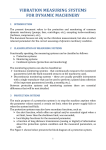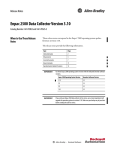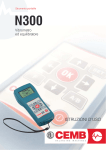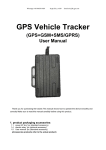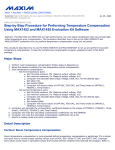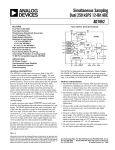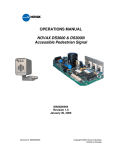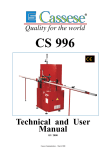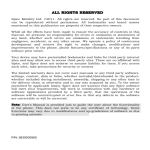Download CXB English manual for Balancing 1plane-2Transducers
Transcript
CXBalancer® 1-plane Balancing with 2 Transducers Rev. 1.0 – 17.07.2014 MaintTech Norrkoping Sweden phone: +46 707 732274 e-mail: [email protected] website: www.mainttech.se Note: Instrument Screens design can be changed in the future software version and can be changed without any notice. The screen shots at the present Manual are for reference only. CXBalancer® 1. Introduction It is generally known that a measurement made with two transducers is better than the same procedure using only one transducer. Then, why the one plane field balancing is not usually performed with both transducers available in the Toolbox? The answer is: probably, most of the balancing instruments don’t have such a software. One plane balancing with two transducers is no longer a revolutionary method and it isn’t even a novelty. It is theoretically very well known for long time ago. Then, the logical conclusion is that this simple method was "forgotten" by most of the producers of balancing instruments, as they often forgot the real needs of the end users. The CXBalancer series have two standard vibration transducers and a software menu, specially dedicated to the balancing purpose. This paper will present you some examples of use, whenever possible, of this method, particularly for field balancing. 2. A simple case Let's assume that we have to perform one plane balancing for the rotor shown below, in figure 1. P1 B1 B2 Because B1 is the closest bearing to the balancing plane, we’ll choose it as a mounting place for the transducer. Normally, when proceeding the "traditional" one plane balancing, we’ll take as transducer’s direction (horizontal or vertical), the one with the higher vibration. If we use the method with two transducers, we’ll place one in the horizontal direction and the other one in the vertical direction (both of them on B1 bearing). B1 – 1st Bearing B2 – 2nd Bearing P1 - Balancing plane Figure 1 We will perform the balancing with two transducers, in accordance with The User Manual and the value of the unbalance that should be compensated will appear on the screen, as shown below (Figure 2): Onto the right side screen will appear two correction values: one measured with VIB1 transducer and the other one measured with VIB2 transducer. Onto the left side screen will be displayed the proposal of the balancing instrument. This may be the measurement of VIB1, VIB 2, or a combination of them. The proposed correction amount will reduce the vibration, if applied. 2 CXBalancer® Figure 2a – The initial vibration Figure 2b – The proposed correction In this simple case, the advantage becomes obvious: the correction value proposed by the instrument is the best choice in order to decrease vibrations in both directions. Here you have a few tips when applying this balancing method. Just notice the initial vibration: the phase shift between the two vibrations will be around 90° (i.e. the angle between the positions of the two transducers). If it is not confirmed, it means the machine has also a major misalignment problem. The calculated correction amounts should be close values, even if the vibrations are completely different. Otherwise, all the other major problems of the machine should be investigated and solved before balancing. 3. A common case We have to perform a field balancing for the rotor shown in Figure 3. Normally, this rotor requires a two plane balancing, which is difficult to be performed in situ. P1 22.2 mm/s Furthermore, the vibrations measured on the two bearings are: B1 B2 VB1 = 22.2 mm/sec and VB2 = 3.14 mm/sec B1 – 1st bearing B2 – 2nd bearing P1 - Balancing plane Figure 3 In this situation we propose to do only a single plane balancing in P1, where we get a higher vibration. The VIB1 transducer will also be mounted onto B1 bearing. 3 CXBalancer® If we're going to perform a "traditional" one plane balancing, more than likely that VB1 vibration will decrease. But what will happen with the vibration measured onto the B2 bearing? From experience, we just know that this value will usually change. How can we assess whether the "total" vibration (of both bearings) was reduced or not? The scalar addition is incorrect. So, the "total" vibration V is not the sum of the two vibrations VB1 and VB2, i.e. 25.34 mm/sec, but it is correctly calculated in accordance with the formula: mm/sec. , that means 22.42 Let's do a balancing using the two transducers’ method. Obviously, we will place them onto both bearings available: B1 and B2 respectively. In Figure 4 can be seen the initial vibrations measured on both bearings: Figure 4 – The initial vibrations The final result obtained after correction, in VIB1 plane (Figure 5), is similar to that shown in Figure 2. Figure 5a - The final amount of unbalance Figure 5b – The final vibrations So, after the correction in accordance with instrument recommendations, the final vibrations were obtained: 4 CXBalancer® VB1 = 0.42 mm/sec and VB2 = 1.82 mm/sec It is observed that both vibrations decreased comparing to the initial values (Figure 4). Since the correction was done in VIB1 plan, it’s obvious that VIB2 vibration decreases less. The „total” vibration becomes now , which is significantly lower. Even if VIB2 vibration would not be dropped, the „total” value would have been: , that is substantially less than the initial value of 22.42 mm/sec. So, the balancing result is positive. (Remember: Field balancing tries to reduce the level of vibrations, but not necessarily to get a "quality grade," according to ISO 1940/1). 4. A special case Inaccessible P2 m = 4 Kg Let’s suppose we have to balance the rotor shown in Figure 6. The initial measured vibrations onto the bearings are: VB1 = 22.23 mm/sec and B1 B2 VB2 = 9.4 mm/sec Obviously, we’ll want to reduce vibrations onto B1, but P1 balancing plane is inaccessible. B1 – 1st bearing 1 What can we do in this case? B2 – 2nd bearing P2 - Balancing plane Figure 6 Will we succeed to reduce the vibrations by performing a "traditional" one plane balancing, mounting the transducer on B1 bearing, or by using P2 as a balancing plane? See below the result obtained after the trial run (Figure 7). 5 CXBalancer® Figure 7b – Trial run Figure 7a – Initial run Figure 7c – The correction mass proposed by the instrument The correction amount required is 60.2 g. In this case is easy to see that the correction mass is enormous (rotor mass being only 4 Kg!). In the field is very difficult to appreciate if a correction mass is "large" or "small", so it’s easy to make mistakes with catastrophic effects. Now let's perform a balancing with two transducers placed onto the bearings, B1 and B2. The result obtained after the trial runs is shown in Figure 8. It is observed that the proposed correction is only 2.7 grams, which is a reasonable value. Figure 8 6 CXBalancer® By making the proposed correction, the residual unbalance will be the one seen in Figure 9. Figure 9a - Initial values Figure 9b - The values after balancing It is easy to observe that the vibrations have decreased significantly from 9.4 mm/sec to 0.3 mm/sec, but only on the B2 bearing. In the meantime, the vibrations onto B1 (to which we intended to drop the vibrations), practically remained unchanged (from 64.6 to 64.0 mm/sec). Furthermore, a negligible correction of 0.1 grams is now required, so there is nothing to be done. However, after balancing the overall level of vibration decreased with 17%, fact that hasn’t solved the issue of lowering the vibration for the plane VIB1. Notice that the balance has been made in terms of safety, as there has been added an acceptable correction mass, but the final result is not satisfactory, yet. The solution in this case is to dismantle the rotor and to balance it onto a balancing machine, in the workshop. Without access to the balancing plane near B1, a better balance it’s impossible. 5. A strange case. .. We intend now to perform a two plane balancing for the rotor in Figure 10. m = 4 Kg P1 P2 B2 B1 B1 – 1st bearing 1 B2 – 2nd bearing P1, P2 - Balancing planes Figure 10 7 CXBalancer® Figure 11 In accordance with the indications on the screen, it comes necessary to add abnormally large correction masses (Figure 11). By splitting the VIB1 and VIB2 vibrations in STATIC and COUPLE components (you can do this by pressing MENU and selecting Static/Couple) we’ll get the next screen (Figure 12): Figure 12 The static component is small, but the couple one is very high. What is the cause? To get the answer, we’ll have to analyze the relative vibration obtained after performing all three trial runs (Figure 13). Figure 13 a – Initial run Figure 13b- First trial run 8 CXBalancer® Figure 13 c - Second Trial run We can observe that both trial weights mounted in VIB1 and VIB2 planes, produce roughly the same effect (5.38, 5.43; respectively, 13.34, 13.22). The conclusion, in this case, is that a two plane balancing is neither required nor possible, being recommended only one plane balancing with two transducers. Here are the results: Figure 14a- The proposed trial weight Figure 14 b – The final unbalance It is also confirmed that vibrations were decreased onto both bearings (Figure 15). Figure 15 9 CXBalancer® 6. Conclusions This document tried to explain you, in a few simple examples, the advantages of using two transducers when performing one plane balancing. Of course, the arguments of the method listed above would have been much stronger if they had been mathematically proven. I did this, not because the formulas are a deep "secret" to me, but simply in order to offer you the pleasure of doing it by yourself. Please, also, do not hesitate to share us any personal success related to the use of the instruments manufactured by us. IMPORTANT NOTE Although MaintTech Sweden believes reasonable efforts have been made to ensure the accuracy of the information contained in this document, it may include inaccuracies or typographical errors and may be changed or updated without notice. It is intended for discussion and educational purposes only and is provided "as is" without warranty of any kind and reliance on any information presented is at your own risk. 10 CXBalancer® Balancing with two Transducers in one Plane I Overview 1 Introduction Typical one plane balancing procedure uses a single transducer. The measurements describe only the status of a single bearing of the rotor assembly. In many situations this is not enough to appreciate properly the status of the assembly. This procedure has been developed to provide to the operator necessary information about both bearings of the assembly in order to improve balancing results and to make balancing procedure safer. This new procedure takes advantage of CX Balancer design; it provides simultaneous measurement on 2 channels, so the second measurement will not deteriorate response time. All vibration measurements done during the procedure will be shown for 2 transducers, similar with two plane balancing procedure. Briefly, the program calculates the results for both measurements (VIB1 and VIB2) and plane selected using normal 1 plane balancing algorithm and assist the operator to select the best choice. 2 When to use? Before to start balancing a vibration measurement and analysis procedure should be carried out. This must determine if the unbalance is the predominant cause for vibration. Also the 1XRPM values should be analyzed in order to determine the bearing and directions where they are bigger. Also the rotor configuration must be analyzed (report between width and diameter and also distance between bearings) in order to decide if one plane balancing is suitable for it. a Instead of regular 1 plane balancing This 1 plane balancing using 2 transducers procedure is recommended anytime when the rotor can be balanced in 1 plane. Do not use it instead of two plane balancing procedure. Typically you should attach the VIB1 transducer on the bearing where the vibration amplitude is higher. Note that the balancing report will refer to the values computed using VIB1 values. Normally, the second transducer should be attached on the other bearing on the same direction. This will provide a better control towards the rotor assembly. However, when for the same bearing the report between the amplitudes on different direction is high (and/or you are suspiciously about other mechanical problem as resonance or misalignment) it is better to attach the transducer on the same bearing but on perpendicular direction versus VIB1. This will provide a better control towards the unbalance response. b When there are not accessible 2 planes for balancing. As noted above, this procedure cannot be used instead of 2 plane balancing. However, in order to reduce the vibration throughout the rotor bearings when in-site as this procedure will assist the operator to find a compromise solution. Compared with normal 1 plane balancing, this will provide a better control. If the unbalance location is close to balancing plane the procedure can produce even good results. 11 CXBalancer® II Description 1 Procedure From Balancing menu, select New One plane 2 Tr. Balancing The program will enter in Configure Balancing. There are not differences compared with 1 plane balancing. The user should press Continue after adjusted the settings. 12 CXBalancer® The program will enter in main balancing screen- Free run mode. This is similar with 1 plane balancing, except that on right panel it displays the vibration measurements of VIB2 transducer. Please notice the title in window header which is Balancing2T – Free run. The rotor parameters are similar with 1 plane balancing. The difference appears on Trial run. Compared with one plane balancing, there will be a right panel where the instrument displays the measurements of VIB2 transducer. This is the only difference. vibration There are the same 2 steps and the same handling. After trial runs are done, the user should press ESC (as usual) to enter in main balancing screen – balancing mode. When the units of unbalance are selected the screen will look like below. 13 CXBalancer® Recommended unbalance correction Vib1 results Vib2 results panel panel Unlike 1 plane balancing, there are 2 new panels in the right. Also the meaning on upper left panel is changed. 1. Vib1 results panel contain the results of 1 plane balancing using the transducer VIB1. This is similar with the values of normal 1 plane balancing. 2. Vib2 results panel contain the results of 1 plane balancing using the transducer VIB2. This is similar with the values of normal 1 plane balancing session if VIB1 transducer would be attached in actual position of VIB2 (remember that 1 plane balancing uses only VIB1). 3. Recommended unbalance correction. Those are the values recommended to attach to rotor in order to do balancing. 14 CXBalancer® 2 Data analysis(How to use new data) 1. If the values shown in VIB1 results and VIB1 results are similar then the rotor can be balanced in one plane. In this situation the recommended value is an average of the two values. (VIB1 label AND VIB2 label should be shown with yellow color) 2. If the values shown in VIB1 results and VIB2 results are opposite as angle but the values are closer together then the rotor cannot be balanced in one plane. Correct balancing must be done in 2 planes. Just a small correction will be possible. In this situation the recommended value is an average of the two values. (VIB1 label AND VIB2 label should be shown with yellow color) 3. If one of the values the values shown in VIB1 results and VIB1 is much bigger than the other, this means that the vibration of the bearing with higher calculated correction mass is not influenced by unbalance in selected plane(see figure above, VIB2). In this situation the recommended value is the smaller one (VIB1 above). When attach weight to this position, just vibrations in specific bearing will be reduced (e.g. VIB1 above). If the other bearing has bigger vibration, the rotor cannot be balanced using selected plane (thus selected plane is not suitable to reduce vibrations on the other bearing). 3 How instrument recommend corrections The aim of in-site balancing is to reduce the vibration level on both bearings. The algorithm calculates the combined remaining vibrations (VIB12+VIB22) for 3 solutions: Attach of correction mass calculated for one plane balancing using the transducer VIB1 (values shown in VIB1 results panel) Attach of correction mass calculated for one plane balancing using the transducer VIB2 2 (values shown in VIB2 results panel) Attach of vector average correction mass between VIB1 and VIB2 The instrument will recommend the situation when remaining vibrations will be minimum and will display this in recommended unbalance correction panel. III Conclusion This feature provides new information to the operator during one plane balancing. Those informations will help the operator to achieve better results. 15

















